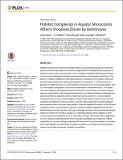Files in this item
Habitat complexity in aquatic microcosms affects processes driven by detritivores
Item metadata
| dc.contributor.author | Flores, Lorea | |
| dc.contributor.author | Bailey, R. A. | |
| dc.contributor.author | Elosegi, Arturo | |
| dc.contributor.author | Larrañaga, Aitor | |
| dc.contributor.author | Reiss, Julia | |
| dc.date.accessioned | 2016-11-02T11:30:35Z | |
| dc.date.available | 2016-11-02T11:30:35Z | |
| dc.date.issued | 2016-11-01 | |
| dc.identifier | 247064267 | |
| dc.identifier | 4b5dfad0-0f8b-433a-bdf4-9b98d61277e1 | |
| dc.identifier | 84993995134 | |
| dc.identifier | 000386714200017 | |
| dc.identifier.citation | Flores , L , Bailey , R A , Elosegi , A , Larrañaga , A & Reiss , J 2016 , ' Habitat complexity in aquatic microcosms affects processes driven by detritivores ' , PLoS One , vol. 11 , no. 11 , e0165065 . https://doi.org/10.1371/journal.pone.0165065 | en |
| dc.identifier.issn | 1932-6203 | |
| dc.identifier.other | ORCID: /0000-0002-8990-2099/work/39600105 | |
| dc.identifier.uri | https://hdl.handle.net/10023/9749 | |
| dc.description | LF was supported in part by the Spanish Ministry of Economy and Competitiveness through the project SCARCE Consolider-Ingenio CSD2009-00065. | en |
| dc.description.abstract | Habitat complexity can influence predation rates (e.g. by providing refuge) but other ecosystem processes and species interactions might also be modulated by the properties of habitat structure. Here, we focussed on how complexity of artificial habitat (plastic plants), in microcosms, influenced short-term processes driven by three aquatic detritivores. The effects of habitat complexity on leaf decomposition, production of fine organic matter and pH levels were explored by measuring complexity in three ways: 1. as the presence vs. absence of habitat structure; 2. as the amount of structure (3 or 4.5 g of plastic plants); and 3. as the spatial configuration of structures (measured as fractal dimension). The experiment also addressed potential interactions among the consumers by running all possible species combinations. In the experimental microcosms, habitat complexity influenced how species performed, especially when comparing structure present vs. structure absent. Treatments with structure showed higher fine particulate matter production and lower pH compared to treatments without structures and this was probably due to higher digestion and respiration when structures were present. When we explored the effects of the different complexity levels, we found that the amount of structure added explained more than the fractal dimension of the structures. We give a detailed overview of the experimental design, statistical models and R codes, because our statistical analysis can be applied to other study systems (and disciplines such as restoration ecology). We further make suggestions of how to optimise statistical power when artificially assembling, and analysing, ‘habitat complexity’ by not confounding complexity with the amount of structure added. In summary, this study highlights the importance of habitat complexity for energy flow and the maintenance of ecosystem processes in aquatic ecosystems. | |
| dc.format.extent | 15 | |
| dc.format.extent | 1367922 | |
| dc.language.iso | eng | |
| dc.relation.ispartof | PLoS One | en |
| dc.subject | Decomposition | en |
| dc.subject | Biodiversity | en |
| dc.subject | Ecosystem functioning | en |
| dc.subject | Functional response | en |
| dc.subject | QH301 Biology | en |
| dc.subject | NDAS | en |
| dc.subject | BDC | en |
| dc.subject.lcc | QH301 | en |
| dc.title | Habitat complexity in aquatic microcosms affects processes driven by detritivores | en |
| dc.type | Journal article | en |
| dc.contributor.institution | University of St Andrews. Statistics | en |
| dc.contributor.institution | University of St Andrews. Centre for Interdisciplinary Research in Computational Algebra | en |
| dc.identifier.doi | https://doi.org/10.1371/journal.pone.0165065 | |
| dc.description.status | Peer reviewed | en |
This item appears in the following Collection(s)
Items in the St Andrews Research Repository are protected by copyright, with all rights reserved, unless otherwise indicated.

